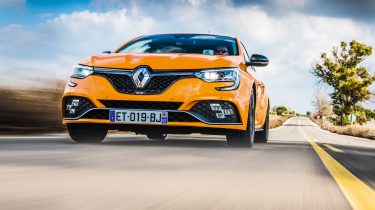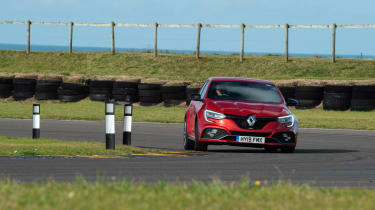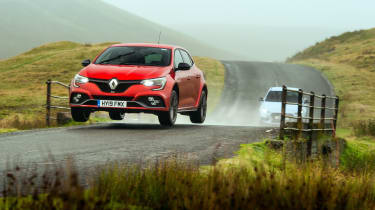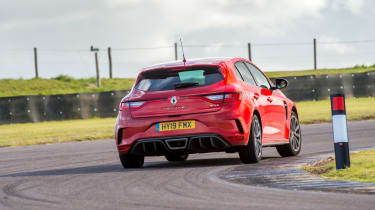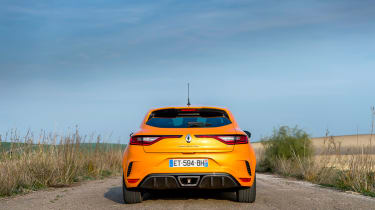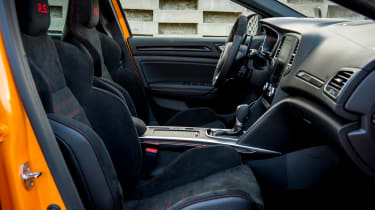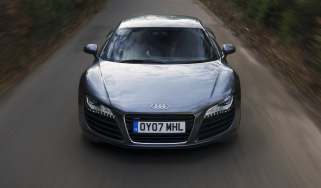Renault Megane RS cup chassis (2018-2020) review – sharp, even when you don't want it to be
It's fast, grippy and genuinely involving, but it's not the best Renault Sport Megane you can buy...
The Renault Megane RS has long been an evo favourite. From the tamest Cup model to the stripped out Trophy R, this French fast hatch has always been at or near the head of the class. Even in the face of newer and quicker competition, the previous generation Megane proved its credentials time and again as the driver’s choice. No pressure for this all-new version, then.
Since the old car went off sale, the hot hatch landscape has changed massively and now includes standout performers such as the Honda Civic Type R and Hyundai i30N, plus revised versions of the Peugeot 308 GTi and VW Golf GTI. So in an effort to maintain its position as the brand behind the top pocket rocket, Renault Sport has gone to town on this latest version, incorporating a host of new technologies aimed at delivering the sharpest and most engaging driving experience. Spearheading this roll call of hi-tech innovations is the 4Control four-wheel steering system, but there are also hydraulic bump stops, an EDC twin-clutch gearbox (don’t worry, there’s a manual too) and a down-sized 1.8-litre turbo that’s every bit as powerful as the old 2-litre.
More reviews
In-depth reviews
Reviews
- Renault Megane E-Tech 2022 review
- Renault Megane RS 300 2021 review – less is more with this GTI rival
- Renault Megane RS sport chassis (2017-2020) review – forget the Trophy, basic is best with the Megane RS
- Renault Megane RS Trophy (2019-2020) review – is this Renault Sport’s redemption?
- K-Tec Racing Mégane review
- New Renault Megane GT and diesel review
Bulging wheelarches hide front and rear tracks that have been widened by 60mm and 4mm respectively, while at the rear is an aggressive diffuser that generates enough downforce to negate the need for a Civic-style spoiler. There are 18-inch alloys as standard, while cars equipped with the optional Cup chassis get 19-inch rims. Other changes include the adoption of the RS Vision LED lamps from the smaller Clio, plus the bold Volcanic Orange paint finish that joins the similarly startling Liquid Yellow.
Inside, the standard Megane is given a through overhaul courtesy of a pair of high-backed and heavily bolstered front seats, aluminium pedals and some trim inserts that look like a cross between carbon and chequered flag. Yet the biggest addition is the new RS Monitor that allows drivers to display a huge array of performance data on the 12.3-inch infotainment screen. Monitor expert also allows you to video laps on track days and share them on social media, if that’s your thing.
> Renault Sport Clio 220 Trophy review
Technical highlights
Well, where do you start? Perhaps the most intriguing innovation is the four-wheel steering system, which is a heavily revised version of that already seen on the Megane GT. The electronically controlled set-up features actuators that can turn the rear wheels up to 2.7 degrees in the opposite direction to the fronts, or up to 1 degree in the same direction – this changeover happens at 37mph in all modes other than Race, which switches at a much higher 62mph. The idea of the set-up is that it boosts agility at low speeds by more quickly pointing the nose of the car at the apex, while also increasing stability and grip when going faster.
All versions of the Megane get hydraulic bump stops as standard. These units are more sophisticated versions of those seen on the Clio and feature greater scope for tuning stroke and maximum load. The adoption of these rallying-inspired dampers means Renault hasn’t felt the need to develop adaptive dampers for the Megane. As before there will be a Cup chassis option, which brings 10 per cent stiffer springs, larger 19-inch alloys and a limited-slip differential (a Torsen type as opposed to the old car’s GKN mechanical locker). Another option for the Cup is the new cast iron and aluminium composite front brake disc set-up, which results in a total saving of 3.6kg in unsprung mass. As with the standard set-up, these discs are 355mm in diameter and are clamped by Brembo calipers.
Engine, transmission and 0-62mph
Under the bonnet is a revised version of the 1.8-litre four-cylinder unit that made its debut sitting in the middle of the Alpine A110. In the Megane it produces 276bhp and 288lb ft, and while both these figures lag behind the Honda Civic Type R’s output, the Renault is lighter. The Megane’s cylinder head has been designed in cooperation with Renault’s Formula 1 squad and includes the adoption of a new, faster acting twin-scroll turbo. The engine also gets the same mirror bore coating that’s used in the Nissan GT-R, while there’s also a higher capacity, dual intake air filter.
At the other end of the car is a neat exhaust system that aims to blend refinement with a sporty soundtrack without resorting to complicated electrically actuated flaps. Instead there’s a cleverly designed back box that delivers a muted burble at idle, yet as engine speeds rise the change in pressure causes the gases to bypass the longer silencer tube and head straight for the exit pipe to create a louder straight-through set-up.
On the move the new engine feels stronger than its smaller capacity and average power and torque figures would suggest. It pulls hard from low revs – there’s no turbo lag to speak of – and spins enthusiastically and with an addictively rorty note all the way to the 7000rpm cut out. It’s enhanced by the exhaust, which emits a purposeful tone at low speeds, a satisfying rasp when extended and a muffled fusillade of pops and bangs on the overrun. It’s sporty without getting irritating and ostentatious.
If there’s a disappointment, then it’s the EDC twin-clutch gearbox. Make no mistake, it’s a vast improvement over the Clio’s similar set-up and allows the Megane to dispatch the 0-62mph sprint in just 5.8sec, but the six-speed unit still lags someway behind the best. It’s smooth and seamless enough when left to its own devices, while it responds fairly crisply to the (slightly small) column mounted paddles. However, it will shift up automatically even when manual changes are selected in Sport mode (you need Race for total control over the electronics), while downshifts can be a little jerky. Select Race and the changes are delivered with a jolt that’s clearly designed to hint at race-bred sportiness, but which actually proves to be irritating. A few laps of Jerez circuit in the manual version revealed that this slick and short throw transmission is the one to go for.
What’s it like to drive?
All these technical innovations are well and good, but what we all want to know is do they improve the driving experience and allow the Megane to maintain its status as driver’s favourite? Well, let’s cut to the chase and give the latest Megane a big thumbs up, but with a couple of caveats.
Let’s deal with that 4Control steering first because, let’s face it, if anything’s going to put a dampener on the dynamics it’s this. There’s no denying that the sensations you feel in first few miles are a little unnerving. Through a roundabout, for instance, there’s the curious feeling of the rear of the car swaying from side to side as you twirl the wheel this way and that. Point the nose into a fast corner and you’ll find yourself having to open the steering just a fraction as the Renault turns in quicker and more sharply than you anticipate. However, get past the initially unsettling reactions and the slightly lifeless yet precise steering and you soon learn to appreciate and exploit the set-up. It makes most sense in Sport or Race settings, where the system reacts faster and, in the case of the latter, continues to turn the rear wheels in the opposite directions as the fronts at much higher speeds (up to 62mph) to deliver the sort of angle of attack that usually happens when the rear of the car has come unstuck and is gently rotating. It’s eerie at first, but learn to trust it and the Megane can carry impressive speed through a series of bends.
The Renault’s composure is enhanced by the excellent damping of our standard Sport chassis equipped car, which works in combination with the hydraulic bump stops to deliver impressive control, even over the gnarly tarmac of our Spanish test route. On really big compressions you expect a sickening crash and shudder as the suspension hits the limit of its travel, yet the Megane simply shrugs it off and continues at unabated speed. Despite cast iron body control and low roll handling, the Renault rides with rare suppleness for a passively damped machine.
Finally, the Brembo brakes do fine job of shedding speed. The pedal action is a little sensitive at the top of the travel, but beyond this the set-up is progressive, powerful and easy to modulate.
Click on the links below for our review of the other Renault Mégane RS models in the range
Price and rivals
Renault has released UK prices, starting at £27,495. To extract the Megane’s full potential, however, one must tick the Cup chassis option, which will add a further £1500 to the price. The EDC dual-clutch gearbox is a further £1700, those upgraded bi-material brakes a further £900.
In terms of rivals, the large hot hatch class is teeming with talented contenders. Our current class favourite is the Honda Civic Type R, which combines 316bhp, agile handling and astonishing grip with surprising everyday usability. Then there’s the recently arrived Hyundai i30 N, which can’t match the Renault or Honda for outright firepower but is a proper, grown-up performance and hugely impressive first effort for the Koreans. The Peugeot 308 GTi by Peugeot Sport is the dark horse of this group, as its bland looks hide a character that’s both playful and steely. So where does the Renault fit in? Well, we’ll have to wait until we can get a Cup Chassis version with a manual gearbox in the UK to deliver our definitive verdict, but the signs all point to a car that’s going to ruffle a few feathers at the top of the class.
